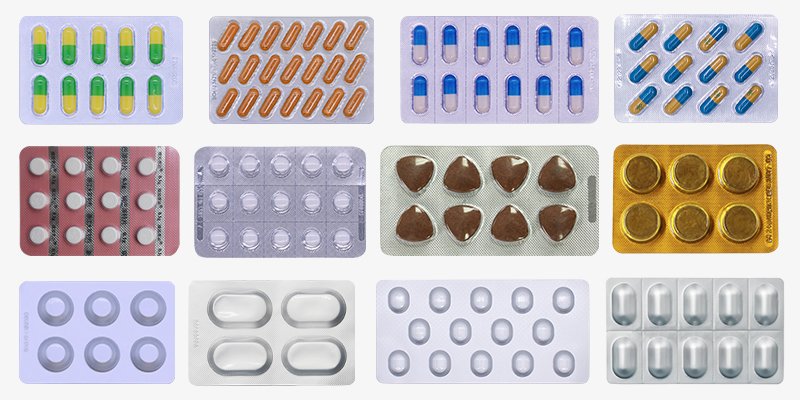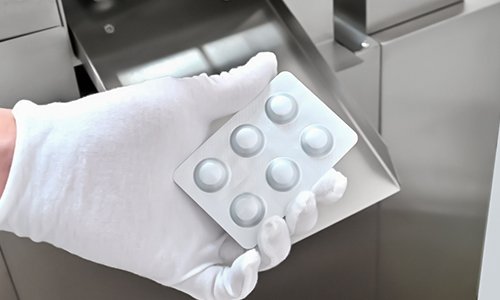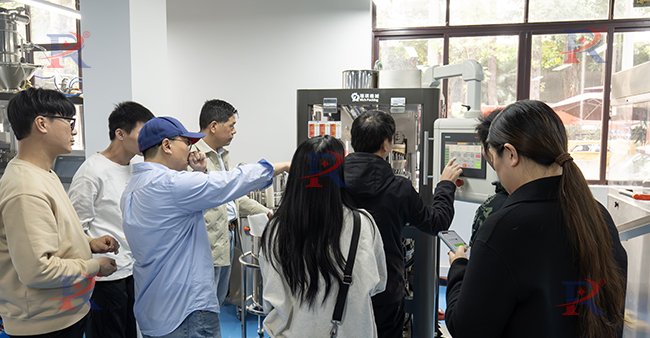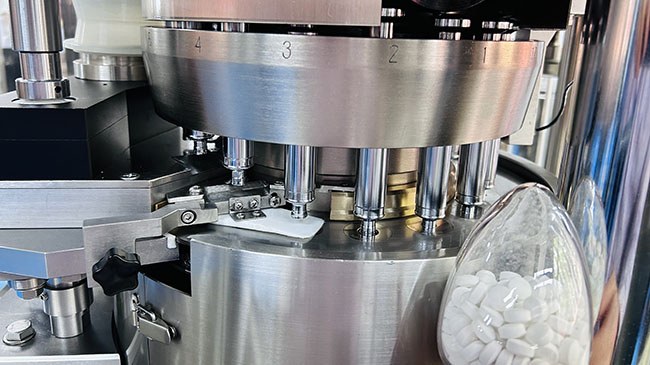Como fabricante de produtos farmacêuticos ou tomador de decisões no processo de embalagem, você sabe que escolher a solução de embalagem certa para o seu produto é fundamental. Você quer garantir que a embalagem não seja apenas funcional, mas também aumente a integridade, a segurança e o apelo do seu produto. Frio blister formado são uma escolha popular na indústria farmacêutica, oferecendo benefícios exclusivos para determinados tipos de produtos. Mas será que são a opção certa para você? Vamos analisar mais detalhadamente a embalagem blister formada a frio, seus benefícios, potenciais desvantagens e se ela atende às suas necessidades.

O que é embalagem blister formada a frio?
A embalagem blister formada a frio é um método em que a cavidade da bolha é criada aplicando pressão a uma folha de metal (frequentemente alumínio) e Filme de PVC sem usar calor. Este processo é diferente da embalagem blister tradicional, que envolve o aquecimento do plástico para formar cavidades.
Papel alumínio: O principal material usado na conformação a frio, fornecendo uma barreira forte para proteger os produtos da umidade, luz e oxigênio.
Filme de PVC: Fornece um revestimento flexível, mas durável, para o produto em seu interior.
A embalagem blister formada a frio é comumente utilizada em indústrias onde a estabilidade do produto é essencial, como os setores farmacêutico, nutracêutico e de saúde. A capacidade de bloquear fatores ambientais a torna uma excelente opção para produtos sensíveis à umidade ou à luz.

Principais benefícios das embalagens blister moldadas a frio
Se você está considerando embalagens blister moldadas a frio, provavelmente está se perguntando sobre as vantagens que elas oferecem. Vamos explorar alguns dos principais motivos pelos quais esse tipo de embalagem pode ser a melhor escolha para o seu produto.
Recurso | Embalagens de bolhas formadas a frio | Blisters tradicionais |
Proteção contra umidade | Alto:O alumínio proporciona uma excelente barreira contra umidade. | Moderado: Filmes de PVC ou PET são menos eficazes. |
Barreira de luz e oxigênio | Excelente:A película oferece proteção completa contra luz e oxigênio. | Limitado:Muitas vezes, apenas uma barreira parcial, dependendo dos materiais usados. |
Inviolável | Superior: O selo forte garante a proteção contra violação. | Moderado: Os selos invioláveis são menos seguros. |
Prazo de validade | Mais longo: Preserva a potência do produto por períodos mais longos. | Mais curto: O produto pode se degradar mais rapidamente. |
Apelo Visual | Prêmio:A película transparente e brilhante proporciona uma aparência elegante e sofisticada. | Básico: Menos atraente visualmente. |
1. Proteção superior para produtos sensíveis
As embalagens blister formadas a frio são ideais para embalagem sensível à umidade, sensível à luz, ou sensível ao oxigênio produtos. A folha de alumínio oferece uma proteção robusta contra umidade, luz e ar, garantindo que o conteúdo permaneça protegido e potente durante toda a vida útil do produto. Se você estiver embalando medicamentos farmacêuticos, vitaminas, ou dispositivos médicos que são propensas à degradação, bolhas formadas a frio são uma solução confiável.
2. Inviolável e seguro
Uma das razões mais convincentes para usar embalagens blister moldadas a frio é a recurso de segurança contra violaçãoA forte vedação resultante da conformação a frio proporciona uma barreira mais segura do que as embalagens blister tradicionais, facilitando a identificação de violações de um produto pelo consumidor. Isso é crucial para atender aos padrões regulatórios e garantir a segurança do consumidor, especialmente ao lidar com produtos farmacêuticos sensíveis.
3. Maior vida útil
Se o seu produto requer armazenamento ou distribuição de longo prazo, as embalagens blister moldadas a frio são uma excelente opção. O lacre hermético impede que fatores ambientais afetem o produto, mantendo-o fresco e eficaz por mais tempo. A conformação a frio proporciona melhor vida útil em comparação com as cartelas tradicionais, que podem não oferecer o mesmo nível de proteção.
4. Apresentação e marca premium
Para produtos que precisam projetar uma imagem de alta qualidade, as embalagens blister moldadas a frio podem elevar a percepção da sua marca. O acabamento liso e brilhante da folha de alumínio oferece um visual atraente e premium que pode ajudar a diferenciar seu produto em um mercado concorrido. Se você está segmentando consumidores de alto padrão, a embalagem blister formada a frio pode aumentar o apelo do seu produto, tornando-o mais desejável.
Possíveis desvantagens da embalagem blister formada a frio
Embora as embalagens blister moldadas a frio ofereçam benefícios significativos, elas podem não ser a melhor solução para todos os produtos. Aqui estão algumas considerações que podem influenciar sua decisão.
Consideração | Embalagens de bolhas formadas a frio | Blisters tradicionais |
Custo de produção | Mais alto:Os materiais e máquinas são mais caros. | Mais baixo: Geralmente menos custoso de produzir. |
Velocidade de produção | Mais devagar:A conformação a frio requer equipamento especializado. | Mais rápido:Mais fácil e rápido de produzir. |
Melhor para tipos de produtos | Produtos sensíveis à umidade e à luz. | Produtos menos sensíveis. |
Impacto Ambiental | Moderado: Mais intensivo em energia e exigente em recursos. | Mais baixo: Mais fácil de reciclar e menos desperdício. |
1. Custos de produção mais altos
As embalagens blister moldadas a frio são mais caras de produzir em comparação com as embalagens blister tradicionais. O maquinário necessário para o processo de conformação a frio pode ser caro e requer conhecimento e experiência especializados. Além disso, os materiais utilizados, como papel-alumínio, tendem a ser mais caros do que os plásticos usados em embalagens blister convencionais. Se o seu produto não exige alta proteção ou se você tem um orçamento apertado, a embalagem blister moldada a frio pode não ser a opção mais econômica.
2. Taxas de produção mais lentas
Os processos de conformação a frio são normalmente mais lentos do que as embalagens blister tradicionais devido à precisão necessária na conformação das cavidades em alumínio. Se você opera em um ambiente onde velocidade Em casos críticos, embalagens blister moldadas a frio podem causar gargalos na produção. Para produções menores ou necessidades de entrega rápida, a embalagem blister tradicional pode ser uma opção mais adequada.
3. Limitado a certos tipos de produtos
As embalagens blister formadas a frio são projetadas especificamente para produtos sensíveis. Se o seu produto não requer proteção contra umidade, luz ou ar, você pode não se beneficiar do custo adicional da conformação a frio. Se o seu produto for relativamente estável e não precisa de uma barreira tão robusta, uma opção de embalagem mais simples pode ser mais adequada.
Quando as embalagens de bolhas moldadas a frio podem não ser a melhor opção para você
Embora as embalagens blister formadas a frio sejam ideais para produtos sensíveis e de alto valor, elas podem não ser a melhor escolha em todas as situações.
Para produtos menos sensíveis
Se você estiver embalando não sensível Para produtos como vitaminas ou comprimidos estáveis e resistentes à degradação ambiental, o custo e a complexidade da embalagem blister moldada a frio podem não ser necessários. Nesses casos, as embalagens blister tradicionais feitas de PVC ou PET podem oferecer proteção suficiente sem o custo mais alto.
Restrições orçamentárias
Para fabricantes que operam sob restrições orçamentárias, os custos mais altos associados à conformação a frio podem ser um fator limitante. As embalagens blister tradicionais são uma alternativa mais acessível para produtos onde a vida útil prolongada e a proteção máxima não são tão essenciais.
Produção em série menor
Se o seu produto for produzido em pequena escala ou se você estiver apenas testando um novo produto, a conformação a frio pode não ser o melhor investimento. O maquinário e os materiais especializados podem exigir um investimento inicial mais alto, o que pode ser difícil de justificar para lotes menores.
Conclusão: a embalagem blister formada a frio é ideal para você?
A embalagem blister formada a frio oferece vantagens significativas para produtos que requerem proteção superior, longa vida útil, e apresentação premium. Se você estiver embalando sensível à umidade, sensível à luz, ou produtos de alto valor, então as embalagens blister moldadas a frio podem ser a melhor escolha para você. No entanto, custo mais alto, taxas de produção mais lentas, e máquinas especializadas necessário pode não torná-lo adequado para todas as situações.
Em última análise, a decisão dependerá das necessidades do seu produto, da sua capacidade de produção e do seu orçamento. Ao ponderar prós e contras, você poderá fazer uma escolha informada sobre se a embalagem blister formada a frio está alinhada com seus objetivos de negócios.


